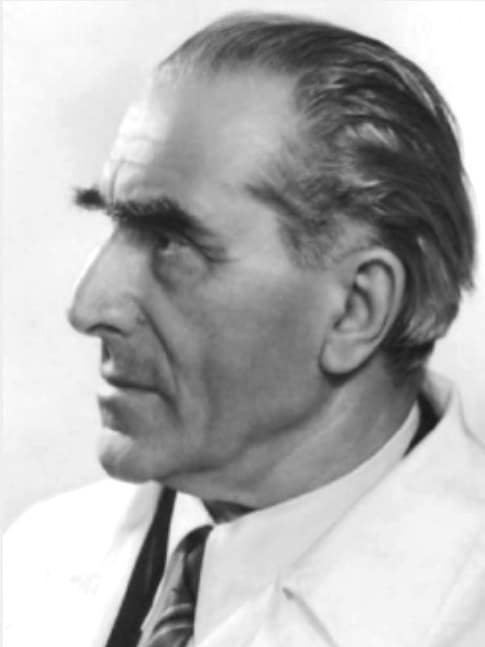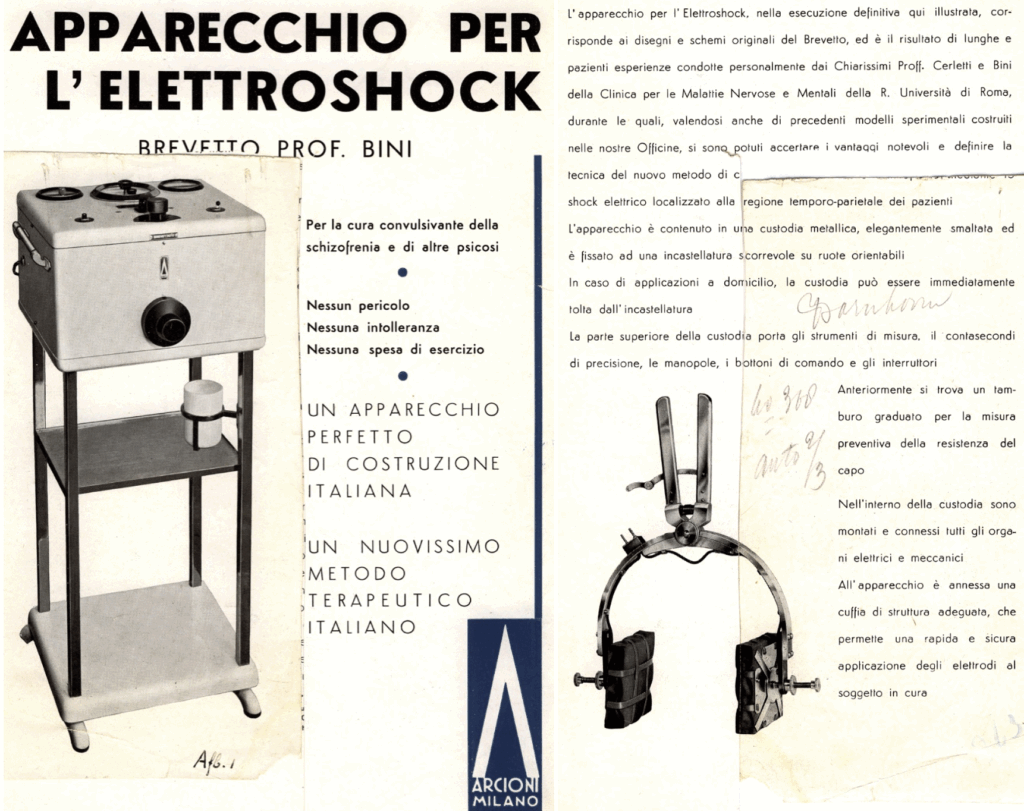Ugo Cerletti

Ugo Cerletti (1877-1963) was an Italian neuropsychiatrist
Cerletti was a psychiatrist and neuropathologist whose invention of electroconvulsive therapy (ECT) in 1938 fundamentally altered psychiatric treatment. With Lucio Bini, he developed and applied controlled electrical currents to induce therapeutic seizures in a man with schizophrenia, achieving striking clinical success. The Cerletti–Bini apparatus became the prototype for modern ECT machines, rapidly adopted across Europe and North America. This intervention predated psychotropic drugs and provided the first consistently effective treatment for severe mood disorders and psychoses.
Cerletti’s career spanned neuropathological research, military medicine, and public health. He trained with leading figures of the early 20th century such as Alzheimer, Kraepelin and Nissl, and led psychiatric institutions in Milan, Genoa, and Rome. After ECT, he proposed that seizures triggered the release of brain-derived compounds he named acroagonines, which he sought to isolate and use therapeutically. Though this line of inquiry was never validated, it anticipated modern neurochemical models of depression and marked him as a forerunner in biological psychiatry.
Though recognised with international honours, he was gradually marginalised within Italian academic psychiatry and did not establish a lasting research school. His last years were marked by isolation and an increasingly nostalgic view of psychiatry’s past.
Biographical Timeline
- Born September 26, 1877 in Conegliano Veneto, Italy
- 1890s–1900s – Studied medicine in Rome and Turin. Trained in neuropathology under Franz Nissl (1860–1919) in Heidelberg; Alois Alzheimer (1864–1915) in Munich; and Pierre Marie (1853–1940) in Paris. Early research included neuroglia, senile plaques, cerebral vasculature, and congenital syphilis.
- 1900–1910s – Conducted early neurohistology research; first to use silver staining for neuroglia and demonstrated their cellular prolongations. Investigated pituitary extracts and endocrine impact on skeletal growth.
- 1914–1918 – Served in WWI; credited with military innovations including white uniforms for alpine troops and delayed-action artillery shells for minefield creation. Awarded Italian military honours.
- 1919–1924 – Director, Neurobiological Institute, Psychiatric Hospital of Mombello, Milan. Published on cerebral malaria, cretinism, and toxic psychoses. Continued pathological research on general paresis and epilepsy.
- 1925 – Appointed Professor of Neuropsychiatry, University of Bari.
- 1928 – Founded neuropsychiatric clinic at the University of Genoa.
- 1935 – Succeeded Sante De Sanctis (1862–1935) as Chair of Mental and Neurological Diseases at the University of Rome La Sapienza.
- 1933–1938 – Animal studies on electric-induced epilepsy; observations in Roman slaughterhouses inspired experiments using electric shock as therapeutic seizure induction.
- 1938 (April) – Alongside Lucio Bini (1908–1964), performed the first electroconvulsive therapy (ECT) on a schizophrenic patient in Rome. Treatment successful after 11 sessions.
- 1940 – Published comprehensive monograph on ECT. Described “antagonism” theory between epilepsy and schizophrenia and introduced concept of “terror-defense reaction.”
- 1948–1958 – Founded the Centre for the Study of the Physiopathology of Electroshock in Rome. Received honorary doctorates from the Sorbonne and University of Montreal.
- 1950s – Developed controversial theory of acroagonines, proposed brain substances generated during seizures. Conducted biochemical extraction experiments to inject melancholic patients with seizure-related compounds.
- 1959–1961 – Emeritus Professor of Psychiatry and Neurology, University of Rome. Attended APA and international psychiatry congresses in the USA and Canada. Visited the UK and was deeply impressed by the welfare state and nursing reforms. Engaged in discussions on post-ECT developments.
- 1963 – Awarded Triennial Gold Medal from West London Medico-Chirurgical Society for contributions to medicine and wartime heroism; died aged 85 in Rome on July 25, shortly before receiving award in person.
Medical Eponyms
Electroconvulsive Therapy (ECT)
On April 11, 1938, at the University of Rome, Cerletti and Lucio Bini conducted the first electroconvulsive therapy (ECT) on a human. After extensive animal studies and practical experimentation in abattoirs using electrical stunning equipment, they applied a controlled current to a patient with paranoid schizophrenia. The induced seizure resulted in significant improvement after repeated sessions.
Cerletti sought a simpler, non-toxic method to provoke epileptic convulsions… Electroshock, unlike cardiazol, induced immediate and absolute unconsciousness… without the distressing latency period… The attack was fundamentally identical to that obtained with cardiazol and should achieve the same beneficial effects—if not more
Cerletti and Bini, 1938
ECT rapidly gained international acceptance as a non-invasive, repeatable alternative to chemically induced seizures. It was significant in the pre-antipsychotic era, offering symptomatic relief in major depression, mania, and catatonia. Despite later controversy and ethical debate, it remains one of the most effective treatments for severe, treatment-resistant depression today.
Cerletti’s invention influenced generations of psychiatrists and helped establish biological psychiatry as a viable framework long before the molecular revolution of the 1950s–70s.
Cerletti–Bini Electroshock Apparatus (1938)
The Cerletti–Bini apparatus was the first device built specifically for electroconvulsive therapy (ECT), developed in 1938 at the University of Rome. Constructed under the supervision of Cerletti and designed by his assistant Lucio Bini, it delivered calibrated electrical currents to induce therapeutic seizures in patients with severe psychiatric illnesses.
We can cause an epileptic seizure in man without danger, by using electricity
Cerletti, May 1938
Originally intended as a research instrument to explore “therapeutic epilepsy,” the device was rapidly adapted for clinical use. A prototype is preserved at the Museo di Storia della Medicina in Rome. Bini was listed as the sole patent holder in Italy, the UK, the U.S., and several other countries. He personally introduced the method internationally, including at the 1939 Copenhagen Neurological Congress

The apparatus marked a shift away from more dangerous or irreversible therapies like insulin coma, metrazol-induced seizures, and lobotomy, offering a repeatable, cost-effective alternative that became a mainstay in psychiatric treatment. Its global dissemination was swift, even as debates over ethical use and historical framing continued
Key Medical Contributions
Acroagonines and Biological Psychiatry
Following his success with ECT, Cerletti pursued the idea that therapeutic effects of convulsions might stem from biochemical agents released by the brain at the peak of the seizure. He named these putative substances acroagonines (Greek akros (extreme) and agon (struggle)) suggesting they were neurohormonal “alarm signals” mobilised during intense stress.
Cerletti believed these compounds were part of a neurophysiological defence system, and began experimental work to extract and purify them from electroshocked animal brains, particularly pigs. By 1947, he attempted to inject acroagonine preparations into melancholic patients, with mixed and anecdotal results.
At the culmination of the seizure, a struggle for life is set in motion, and the brain emits chemical messengers to restore equilibrium.
Cerletti, 1950
Although his acroagonine hypothesis was never validated biochemically and drew increasing scepticism, it foreshadowed later neurochemical theories of mood disorders and psychopharmacology.
Marginalisation and Late-Career Decline
Despite global acclaim for ECT, Cerletti’s later work on acroagonines and biological models of mental illness fell out of favour. By the 1950s, the psychiatric mainstream had shifted toward psychoanalysis and later toward psychopharmacology, leaving Cerletti’s neurophysiological focus somewhat sidelined.
Though recognised with international honours, he was gradually marginalised within Italian academic psychiatry and did not establish a lasting research school. His last years were marked by isolation and an increasingly nostalgic view of psychiatry’s past.
Major Publications
- Cerletti U. Sopra alcuni rapporti tra le cellule a bastoncello e gli elementi nervosa nella paralisi progressiva. Rivista Sperimentale di Freniatria 1905;3(3,4):1-15
- Cerletti U, Bini L. L’Elettroshock. Archivio Generale di Neurologia, Psichiatria e Psicoanalisi 1938; 19: 266-268
- Cerletti U, Bini L. Un nuovo metodo di shockterapia: l’elettroshock. Bollettino e Atti della Reale Accademia Medica di Roma 1938; 16: 136–138.
- Cerletti U. Old and new information about electroshock. Am J Psychiatry. 1950 Aug;107(2):87-94.
- Cerletti U. Electroshock therapy. J Clin Exp Psychopathol. 1954 Jul-Sep;15(3):191-217.
- Cerletti U, Cerletti P, D’Angelo C. Potentiation of narcotic action by the brain treated with an electric shock. Nature. 1962 May 12;194:582-3.
- Cerletti U, Bini L. Electroshock. Int Rev Psychiatry. 2018 Apr;30(2):153-154.
References
Biography
- Kalinowsky LB. Ugo Cerletti, 1877-1963. Compr Psychiatry. 1964 Feb;5:64-5.
- Paterson AS. Ugo Cerletti 1877-1963. Br J Psychiatry. 1964 Jul;110:599-600.
- Novelletto A. Ugo Cerletti, in Dizonario biografico degli italiani. Roma: Treccani. 1979
- Passione R. Ugo Cerletti. Scritti sull’elettroshock. Milano: Franco Angeli. 2006
- Passione R. Ugo Cerletti. Il romanzo dell’elettroshock. Reggio Emilia: Aliberti. 2007
- Sandrone S, Cambiaghi M. Ugo Cerletti (1877–1963). J Neurol 2018; 265; 731–732
- Passione R. Ugo Cerletti, inventore dell’elettroshock Una biografia (1877-1963). 2025
Eponymous terms
- Endler NS. The Origins of Electroconvulsive Therapy (ECT). Convuls Ther. 1988;4(1):5-23.
- Passione R. Italian psychiatry in an international context: Ugo Cerletti and the case of electroshock. Hist Psychiatry. 2004 Mar;15(57 Pt 1):83-104.
- Passione R. Ugo Cerletti. Scritti sull’elettroshock. 2007
- Faedda GL, Becker I, Baroni A, Tondo L, Aspland E, Koukopoulos A. The origins of electroconvulsive therapy: Prof. Bini’s first report on ECT. J Affect Disord. 2010 Jan;120(1-3):12-5.
- Metastasio A, Dodwell D. A translation of “L´Elettroshock” by Cerletti & Bini, with an introduction. The European Journal of Psychiatry. 2013; 27(4).
- Gazdag G, Ungvari GS. Electroconvulsive therapy: 80 years old and still going strong. World J Psychiatry. 2019 Jan 4;9(1):1-6.
- Patriarca C, Clerici CA, Zannella S, Fraticelli C. Ugo Cerletti, Pathologica and electroconvulsive therapy. Pathologica. 2021 Sep 23;113(6):481–7.
- Kotsaki K, Diamantis A, Magiorkinis E. Ugo Cerletti (1877-1963): An Early Italian Father of Electroshock and a Pioneer in Many Other Ways. Neuroscientist. 2021 Oct;27(5):454-462
- Kaplan RM. The Man Who First Used ECT: Ugo Cerletti. Psychiatric Times 2021
- Sirgiovanni E. Acroagonines: Ugo Cerletti’s audacious attempt to place the neurophysiological effects of electroconvulsive therapy in vials. Medical History. 2022;66(3):185-206.
- de Mangoux GC, Amad A, Quilès C, Schürhoff F, Pignon B. History of ECT in Schizophrenia: From Discovery to Current Use. Schizophr Bull Open. 2022 Aug 24;3(1):sgac053
- Fischer H. Dr. Ugo Cerletti invents electroconvulsive therapy. Hektoen International 2023
- Sirgiovanni E, Hansson N. “His Discovery Has Revolutionized Psychiatry; It Has Opened Vast Horizons”: Ugo Cerletti, a Missing Nobel Prize Laureate?. The Journal of ECT, March 19, 2025
Eponym
the person behind the name
BA MA (Oxon) MBChB (Edin) FACEM FFSEM. Emergency physician, Sir Charles Gairdner Hospital. Passion for rugby; medical history; medical education; and asynchronous learning #FOAMed evangelist. Co-founder and CTO of Life in the Fast lane | On Call: Principles and Protocol 4e| Eponyms | Books |
